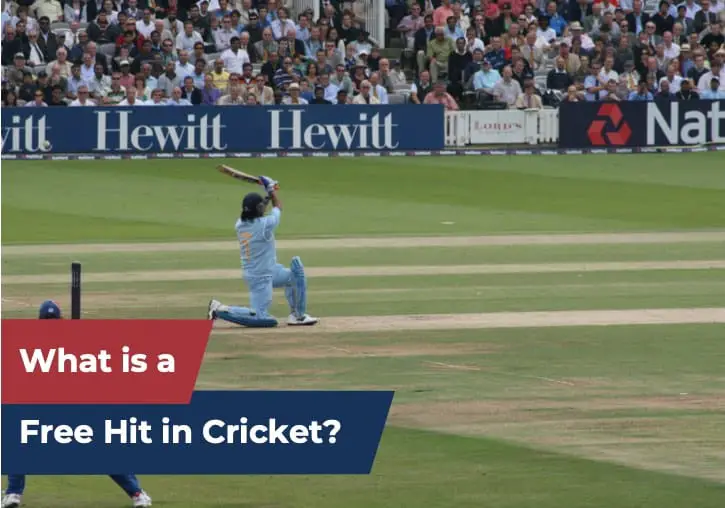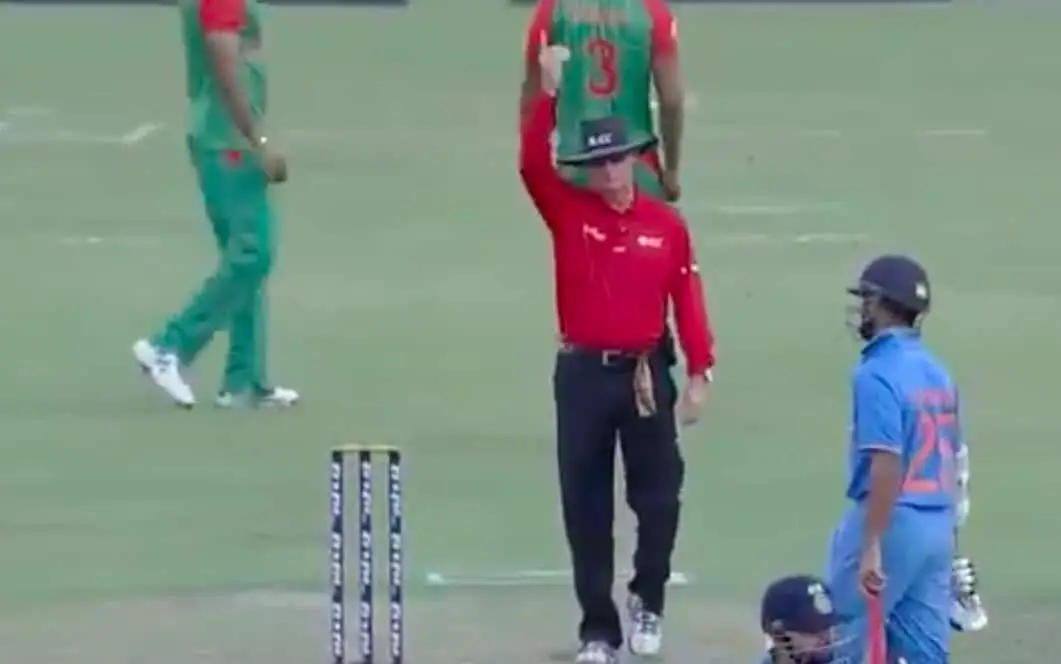
The match is in a crunch situation. Everybody is under pressure – the batsman, bowlers, and even the fielders. The bowler cracks under pressure and delivers a no-ball and a free hit is given! But, what is a free hit cricket and why is it given?
A free hit is awarded to the batting team as an act of penalising a bowler for bowling a No-ball. A batsman can only be dismissed in limited ways on a free hit. The free hit continues until the bowler delivers a legal delivery. The free hit rule is only applicable in limited-overs cricket (T20 & ODI).
Free Hits weren’t always a part of the limited-overs cricket. So, when were they introduced? In what ways a batsman can be out on a Free Hit? Are there any extra rules around it? Let get to bottom of everything there’s to know about a Free Hit in cricket.
What is a Free Hit in Cricket?
In Cricket, a Free Hit is an interesting rule which is applied only in the limited-overs cricket i.e. ODI and T20I cricket. A Free Hit is awarded to the batting team to penalize the bowling team for all kinds of no-ball transgressions.
The Free Hit delivery is the very next delivery after the no-ball. It gives the batsman on strike a free hand in dealing with the delivery as he wishes without the fear of dismissals. There are few exceptions to this rule which we talk about later in the article.
Here’s Rohit Sharma hitting a free hit ball for a six.
Overall, it’s a great opportunity for the batsman to go for that extra Four or a Six and boost the scoring rate for the team.
There can be some funny scenes on the ground when the batsmen start running byes after getting bowled on a Free Hit ball or when they continue running even after the fielder took a clean catch off a Free Hit delivery.
Such is the nature of a Free Hit delivery that the batsmen have all the advantage while the bowlers pay for the mistake made on the previous delivery.
Here’s an unbelievable six off Umar Gul on a Free Hit.
When was Free Hit first Introduced?
Free Hit was first introduced in the 2007 T20I World Cup in South Africa by the International Cricket Council (ICC). It was first supposed to be applied only for the front foot no-balls but ICC clarified that it is too be applied for all foot fault no-balls which was later extended to all kinds of no-balls.
What are the Free Hit Rules in Limited-overs Cricket?
As per the Law 21 of ICC playing conditions for limited-overs cricket, the delivery following a no-ball is declared a free hit by the on-field umpires. It also states that the rule applies all the different no-ball including but not limited to front or back foot no-ball, waist-high no-ball, for throwing the ball, changing the bowling side without notifying the umpires to name a few.
It may happen that the Free Hit delivery is not a legitimate one – it could be a no-ball or a wide ball. In such cases, the next delivery becomes a Free Hit for whichever batsman is on strike. This goes on until the bowler bowls a legal delivery which can be considered one of the over.
A batsman can only get out in limited ways on a Free Hit delivery. A batsman can be dismissed only under the cases that apply to a no-ball, even if the Free Hit delivery is a wide ball.
This means that if the free hit delivery is a wide ball, the batsman cannot be out ‘stumped’. This gives the batsman license to advance down the pitch to try and hit the Free Hit delivery out of the park without the fear of missing it and getting stumped.
The only permitted modes of dismissals on Free Hit are run out, hitting the ball twice, and obstructing the field.
Here is an interesting video of a batsman getting run out stealing a run on the free hit delivery. The batsman is Peter Borren and the match was played in Group A of ICC Cricket World Cup Qualifier in 2018.
Borren hit the Free Hit ball high in the air, the fielder took the catch and immediately threw towards the non-strikers where Borren was caught short.
Are Field Changes allowed on a Free Hit?
For a Free Hit delivery, the changes in the field are not permitted unless there is a change of strike. If the batsman, who faced the no-ball on the previous delivery, is the same batsman facing the Free Hit delivery, the no field changes are allowed. Even the exchange of fielders between fielding position is prohibited.
There is a catch here though. If the no-ball was as a result of fielding transgression, such as having too many fielders outside the circle, then the fielding change is permitted irrespective of who is on strike to face the Free Hit delivery. The fielding change must only be done to correct the error in a fielding position.
Free Hit is really unfortunate for the bowlers. The only respite they have is that they can change the mode of bowling for the free hit delivery. This means they can change the sides or may switch to bowling pace instead of spin and vice versa. The bowlers must inform the umpires of this change or it will be another no-ball.
What happens if the Batsman gets Bowled on a Free Hit?
It might happen that a batsman gets bowled off a Free Hit delivery. If on a Free Hit delivery, the ball hits the bat before going on to hit the stumps, then the batsman gets extra runs despite getting bowled.
If the ball hits the pad or his person before getting bowled, then the runs successfully ran are considered as Leg-Byes. In case when the batsman was clean bowled without any contact with the bat or batsman, then the runs are considered as Byes.
Here’s a video of a batsman getting bowled on a Free Hit delivery. That’s not out. He did not run though, so no runs were added to the score.
Bowled on a Free Hit delivery. That’s not out.
How have the Free Hit Rules Changed Over Time?
When the Free Hit rule was first introduced in the T20 World Cup in South Africa, it was understood that the rule would be applied only in case of the front-foot no-balls.
The International Cricket Council (ICC) released a necessary clarification in October 2007 stating that the Free Hit will apply to the next delivery after a bowler either oversteps with either his front foot or if the back foot cuts the return crease or lands outside of it.
This changed Free Hit rule was introduced in ODIs later in the same year since the abandoned ODI between India and Australia in Bangalore.
In 2015, ICC made another change which stated that Free Hit will be given on the next delivery after any kind of no-ball is bowled. It could be a foot-fault, beamer, or anything type. This was particularly hard on the bowlers.
Now there was a possibility of the bowler getting penalized for someone else’s mistake such as a no-ball occurring due to not adhering to the field restrictions etc.
No further changes were made to the Free Hit rule by the ICC after 2015.
What is the Umpire’s Signal for a Free Hit?

It has to be noted that a Free Hit can only be awarded after a no-ball. Thus, just before signalling for the Free Hit, once the ball is dead, the umpire signals for the no-ball by taking one hand out parallel to the ground around shoulder height.
Once it has been acknowledged by the scorer, he then extends one arm straight upwards and moves it in a circular motion to signal for a Free Hit.
Umpires also keep an eye on the field to catch any transgression by the fielding side in the field change rule of Free Hit. He signals another no-ball followed by a Free Hit signal if such a transgression is observed.
Final Thoughts
The Free Hit is another modern and interesting development in cricket that exciting for the batsmen and the fans but not so much for the bowlers.
Cricket is primarily a batsman’s game, and the Free Hit Rule penalizes the bowler even more irrespective of whether it was the bowler’s fault or not.
The bowlers do have a psychological advantage if they don’t allow the batsman to score off a Free Hit delivery. But more often we see bowlers getting whacked out of the ground on a Free Hit delivery.
But that’s how it is. The rules are rules and they are the same for everyone. Thus, one must learn to make peace with them and go ahead with the game.

